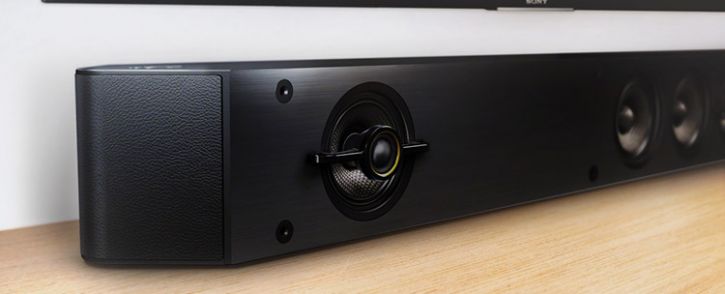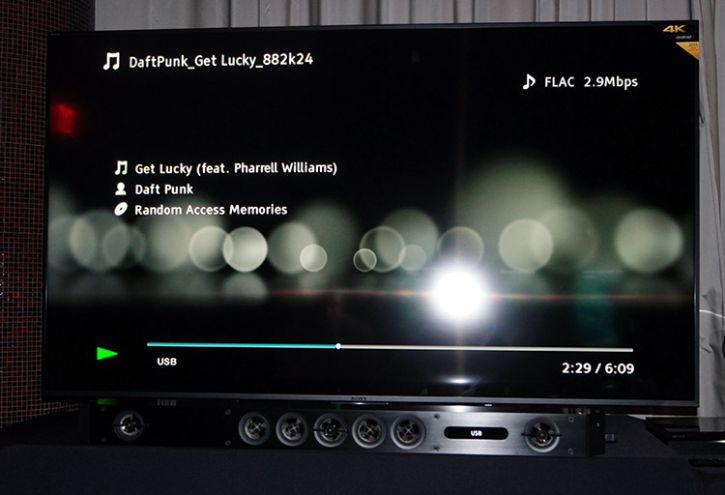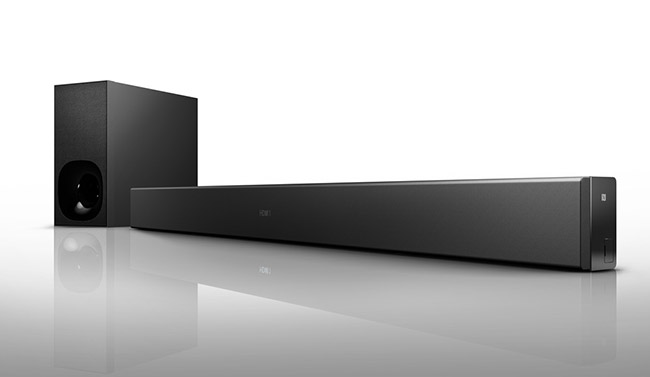As TVs get thinner, so does their sound, which is why the add-on sound bar market is currently booming. But sometimes adding a sound bar to a TV isn't all that simple, nor does it offer a hugh improvement in sound quality. Many TVs degrade the sound when it's passed through an analog or fiberoptic port. Sony is getting around this limitation by offering HDMI source switching right in the sound bar as well as on-board decoding for DTS and Dolby surround and even support for high resolution audio. And their higher end models will support HDCP 2.2 content protection so they're fully compatible with today's and tomorrow's 4K Ultra HD content.
Sony Electronics recently announced details on four new Sound Bars for 2015: the HT-ST9 ($1,499.99), HT-NT3 ($699.99), HT-CT780 ($449.99), and HT-CT380 ($349.99). All offer HDMI source-switching and come with a wireless subwoofer for deeper, more extended bass response. All but the entry-level HT-CT380 support HDCP 2.2 for secure 4K passthrough of copy-protected content.
"We're not just an audio company: we're a video company and a movie studio, too," said Aaron Levine, Senior Manager, Product Marketing at Sony, "so supporting the latest, highest quality video content is just as important as offering excellent sound quality." And as for that sound quality, I spent some time listening to the flagship HT-ST9 at a press event in New York City last month and was impressed with what I heard: a nice wide soundstage, extended bass and dynamics and clear, precise vocals. It's the first soundbar/subwoofer system I've seen (or heard) heard with native support of high resolution audio on-board. Listening to a couple of Hi Res tracks sounded more like an old school "Hi Fi" system than a simple sound bar.

The HT-ST9 and HT-NT3 have Google Cast built in so you can cast your favorite music apps from your phone or tablet to your speakers. Supported devices include Android phones and tablets, iPhone, iPad, Chromebook, and Mac or Windows laptops. By pressing the cast icon, you can search, browse, play, skip, and turn up the volume on your favorite tracks directly. And the SongPal app can allow you to synch music across multiple speakers in the home, wirelessly.

According to the company, the HT-ST9 sound bar and its included wireless subwoofer are tuned by "Academy Award-winning Sony Pictures engineers for world-class cinematic sound." The ST9 features 800 watts of built-in amplification and supports 7.1 channel surround sound from seven discrete amps, ten speaker drivers (seven midrange drivers and three super-tweeters) plus the subwoofer. The speakers are all included in the sound bar and subwoofer, however: there is no support for discrete rear surround speakers. The HT-ST9 includes native support for Spotify Connect. Audio codecs supported by all of the new modesl include Dolby Digital, DTS, DTS 96/24, 96k/24Bit PCM, DTS HD Master Audio, DTS-HD High Resolution Audio, Dolby Digital Plus, Dolby True HD as well as multi-channel PCM decoding (2.1, 5.1, 7.1).
The HT-ST9 includes three HDMI inputs plus one HDMI output with ARC (Audio Return Channel) support. ARC allows you to get sound from the TV's built-in streaming apps or tuner without having to connect a separate audio cable from the TV. Sony included four digital sound fields (selectable on the remote) so owners can customize their listening experience for music, movies, regular TV or sports.
In a unique twist, the HT-ST9 offers both Bluetooth reception and transmission. Bluetooth reception is commonly found on sound bars and wireless speakers as it allows you to pair your phone or tablet to stream music to the speaker. But Bluetooth transmission means you can also pair the soundbar with any Bluetooth-compatible headphones for a more private listening experience. This is something we rarely see on sound bars or even on separate A/V receivers.

The more compact HT-NT3 sound bar with wireless subwoofer offers many of the same features of its bigger brother, but with fewer speaker drivers (two midrange drivers plus two super-tweeters arranged in coaxial drive units) and less amplification power (450 watts). The HT-NT3 offers Hi Res Audio support, three HDMI ports (with ARC-compatible HDMI output), HDCP 2.2 support, Google Cast functionality and Bluetooth streaming from a mobile device or to a pair of wireless Bluetooth headphones.
As we move down the line, the HT-CT780 and HT-CT380 lose Google Cast, multi-room synchronization, and that Bluetooth headphone compatibility. However, both of the lower cost bars do support Bluetooth streaming from your phone or tablet to the bar. On the HT-CT780, the power steps down to 330 watts total, powering two midrange drivers, two super-tweeters and a subwoofer. It keeps the three HDMI ports with ARC-compatible HDMI output and HDCP 2.2 support. The entry-level HT-CT380 offers 300 watts of amplification driving two full-range speakers and a subwoofer. The 380 offers HDMI switching (3 inputs), but does not include HDCP 2.2 support so it's a better match for an HDTV (as opposed to an Ultra HD TV). The HT-CT380 includes Bluetooth reception capability.
The HT-CT380 and HT-CT780 are shipping now, the HT-NT3 is expected in July and the HT-ST9 flagship is expected in June.
| Model | Price | Width | Subwoofer Size | Availability | Order/Pre-Order |
| HT-ST9 | $1,499.99 | 44.5" | 15.8 x 9.8 x 16.8" | June, 2015 | HT-ST9 on Amazon |
| HT-NT3 | $699.99 | 42" | 15 x 7.5 x 15" | July, 2015 | Coming Soon |
| HT-CT780 | $449.99 | 40.6" | 15 x 7.5 x 15" | Available Now | HT-CT780 on Amazon |
| HT-CT380 | $349.99 | 35" | 13.5 x 6.7 × 15" | Available Now | HT-CT380 on Amazon |